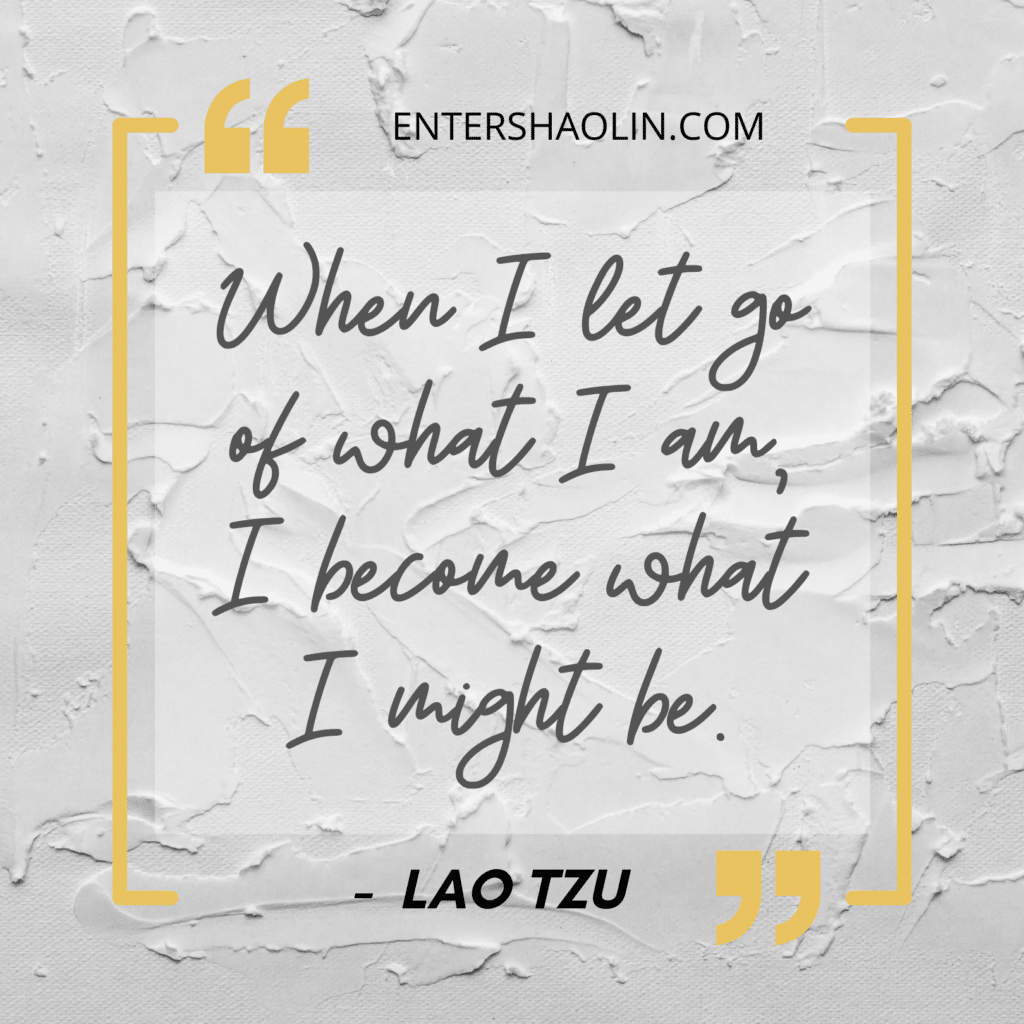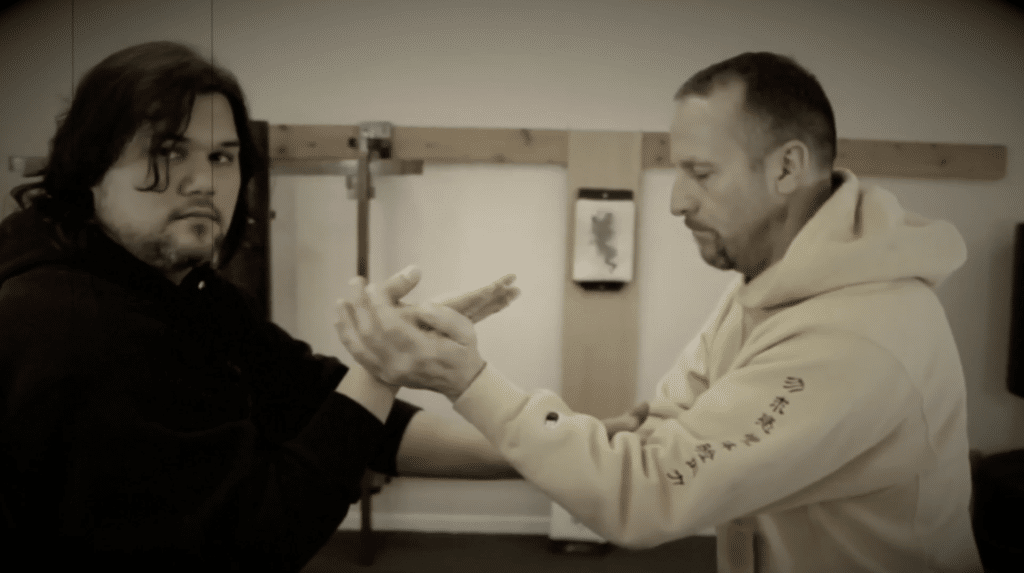One thing that separates Wing Chun from other martial arts is Chi Sao (Sau) also known as Sticky Hands. In the following article we included a video with one of our Chi Sao Demonstrations.
There is also a ton of controversy around Chi Sao. I think a reason for this is people not understanding what sticky hands is actually used for.
While Chi Sao looks fancy it isn’t actually effective to use sticky hands when you are in a fight. The reason is because when you are practicing Wing Chun’s sensitivity training game you are playing by rules.
Rules that don’t exist during a street fight nor do they exist in standard competitions.

So What Is Chi Sao?
Chi Sao helps a person bridge the gap between understanding and applying techniques. Chi Sao is a dynamic exercise. It starts off in a fixed position but quickly changes to more fluid movements once the practitioners get rolling. It’s hard to tell what exactly is going on by watching.
This is because it (chi sau) is a training tool to teach a person sensitivity under stressful conditions. While you can feel what is going on, often times it’s hard to visually see what is happening.
It takes years of experience to truly see what the energy is doing. Chi Sao is also called sticky hands because the idea is once you make contact with your opponent you want to feel like you are stuck to their arms.
Chi Sao can be played many different ways and you can incorporate different rules depending on who you are training with and what goals you set for the training session.
For some people the idea of actually getting hit isn’t something they look forward too. While other folks are looking for that adrenaline rush. So the game itself can be at whatever level you are comfortable playing at.
I have played with people who flinch if I raise my voice and I have played people who don’t acknowledge a hit until they are feeling pain and everything in between.
Through consistent practice your body will learn to become fluid moving between techniques.
What is Dan Chi Sao?
If you are wondering, “what is dan chi sao”? The basic form is a one-handed exercise that incorporates an entire range of striking techniques. In addition, this martial art is an introduction to other forms of kung fu. Whether you are new to the art or just curious about it, you’ll benefit from this overview.
To practice this form, you need to learn proper technique, sensitivity, and structure. You must learn how to respond energetically to your partner, and how to stay with what comes and retreats. Then, you can learn two-arm, single arm, and cross arm moves. You can also train blindfolded if you wish. Blindfold training is a great way to increase your sensitivity. In addition, it’s crucial to start off slow and streamline your movements.
The technique is a hybrid of striking styles, and it focuses on the fundamentals of each. The technique focuses on training the opponent’s tactile sensitivity and automatic reflexes. In Wing Chun, one of the most important aspects of the style is to stay “glued” to your opponent and not let them move. Practice of chi sao develops both of these attributes. The goal of this type of training is to develop an opponent’s “sticky” feeling and prevent fixed points.
Chi Sao Demonstration Is Not Fighting But…

It’s the closest thing to fighting that you can do in your Wing Chun training. With some people the intensity that they play Chi Sao can feel like they are fighting. In fact through the process of practicing with different people you will find moments where you can have an adrenaline dump.
It’s actually good to have them while you are training because you can work on teaching your body how to respond effectively during stressful scary situations.
There is nothing worse than being in a violent situation and freezing up like a deer in headlights.
One of my favorite ways of training Chi Sao is “No Peak or Blind Folded. Here is myself and one of my students practicing no peak Chi Sao..
No Peak Chi Sao Demonstration
Final Thoughts…
The idea behind it is practicing feeling and reading your opponents intentions. Chi Sao is an amazing training aid that helps you bridge the gap between not fighting and fighting.
This is just one of the ways we have here for you at Enter Shaolin to help you develop your sensitivity skill. How did you like our Chi Sao Demonstration?
…Your Turn
Have you played Chi Sao Before? If so what has your experience been like?

Good sensitivity training can definitely put you ahead of the game when your weapon is in contact with your opponents, which is why it was an integrated part of thrust oriented swordsmanship where microseconds could mean the difference between life and death.
I hear ya!
incredible skills!
Thanks, Sifu Phu is a great teacher 🙂
Sifu Larry, I agree with everything that you have said. I’ve played Chi Sao/Sticky Hands Form, with a few different people and depending on their attitudes and level of experience, approach it in different ways. Some try to hit you as fast as they can as if it’s all about speed. Some try to over power you using force, when their body is supposed to be relaxed and rooted. Others understand the concept. But not everybody plays it, in quiet the same way. To me, Chi Sao is not about fighting, it’s about control, it’s about understanding, through touch, the other persons intent. I never look at the person I’m touching hands with, the same way I never look directly at an attacker at the moment of engagement. I look at nothing and see everything, obviously my eyes are not actually closed. I feel their energy throughout my entire body, so I know how to move with it and control them, the art of fighting without fighting. I like to say, if I can see myself doing Chi Sao, then I’m not doing it right. The actual visual movements of Chi Sao become a distraction and takes away the feel. So I prefer to close my eyes and feel the energy. if I can feel it, then I can express it, which in turn allows me to develop my sensitivity, which is always being fine tuned and refined.
Right on!
Sticky hands seems similar to push hands in Tai Chi which I practice in my ongoing classes in Colorado. In push hands you very rarely lose direct contact with your opponent and it is practiced very slowly and gently with no locking of joints and not striking but just unbalancing your opponent. Tai Chi seems more akin to wrestling while sticky hands seems more like boxing. Am I correct?
Hi Jonathan, great observation. In fact I teach my students both chi sao and push hands… I teach them independently until they get a feel for it. Then I combine the 2 sensitivity games.. Finally I break them free from the game and take it to a sparring level. the combination of the 2 games really gives a person a good idea the different fighting ranges.
Some rules make it more physically demanding. My favorite is the Chi Sao table. I have done it without the table and just an agreement to consider it a loss if moved outside a box drawn on the ground.
Right, over the years I’ve done it in confined spaces as well as other variables, rolling on stones, in sand, on the street, on a slide etc.. I am actually going to shoot some videos to help people develop their core and balance while practicing chi sao.
To me that describes/explains Sticky Hands perfectly. The only thing missing is that groovy moment during a Chi Sao session when it “clicks” and the instincts combine with the senses and it rolls.
Thank you so very much!
Beautifully Executed Sifu Larry. ????????????????
Thanks! Right that moment when everything just feels right.
We practice push hands mainly with the goal off balancing our partner, but like Chi Sao, strikes and chin na can be mixed in. It has now been over a year of staying 6 feet apart. It really puts a limit in our training, and most of it is now just form.
Ya this covid thing has really hurt the martial art industry. I mean it’s hard to practice when you can’t touch anyone.